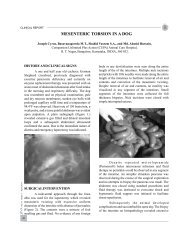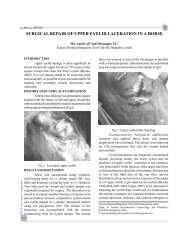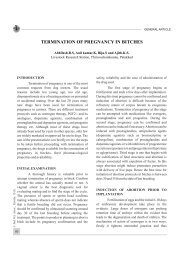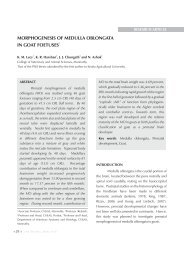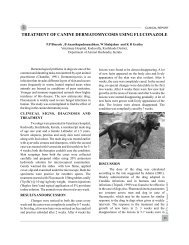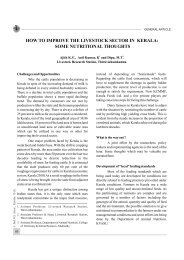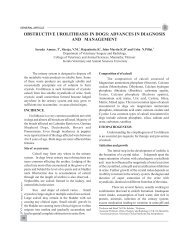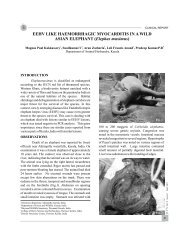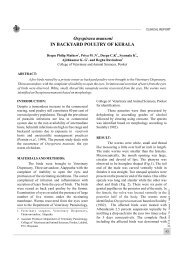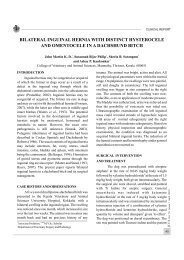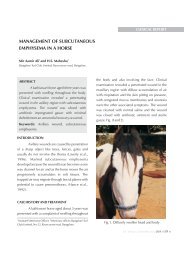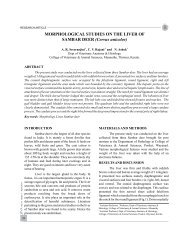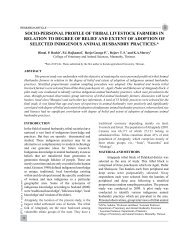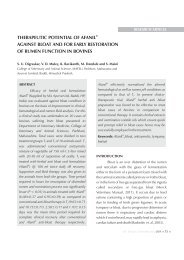2012 Jiva April Cover 220 GSM Art Card Glossy ... - Jivaonline.net
2012 Jiva April Cover 220 GSM Art Card Glossy ... - Jivaonline.net
2012 Jiva April Cover 220 GSM Art Card Glossy ... - Jivaonline.net
Create successful ePaper yourself
Turn your PDF publications into a flip-book with our unique Google optimized e-Paper software.
RESEARCH ARTICLEof five (50 percent) gave an amplicon size of 402 bpfor lktA gene, which indicates the presence of F.necrophorum. None of the samples were found tobe positive for D. nodosus. The detection of F.necrophorum on 50 percent hoof lesions of pigssuggests F. necrophorum is the major contributingfactor for foot bush in pigs. This is consistent withthe findings of Hickford et al., 2010, wherein ahigher proportion of lame cattle were affected withF. necrophorum (53 percent), than D. nodosus (5percent).Fig.1: PCR amplification of lktA geneof F. necrophorumLane 1, 2 and 3: samples, Lane 3: positive controlLane 5: negative controlThis study may not be representative as thesample size was very low and was collected from asingle farm; in addition, samples from healthyanimals were not considered.This study suggests a hypothesis of anincreased association of F. necrophorum with footbush in pigs, than D. nodosus and has veryimportant implications in herd health management.Presence of F. necrophorum in affected pigs can actas a potential source of infection to healthy animalsin the farm, which on secondary infection with D.nodosus may lead to a much more severe condition.Outbreaks by mixed variants of F. necrophorum isnot common, in contrast to report of the presence ofupto seven strains of D. nodosus on a single claw(Zhou et al., 2001). Therefore this study can befurther expanded to identify the strains ofF. necrophorum prevalent in Kerala to develop aneffective vaccine against foot bush in pigs.REFERENCESDhungyel, O. P., Whittington, R. J. and Egerton, J.R. 2002.Serogroupspecifc single andmultiplex PCR with pre-enrichment cultureand immuno-mag<strong>net</strong>ic bead capture foridentifying strains of D. nodosus in sheep withfootrot prior to vaccination. Mol. cellprobes.16: 285-296.Falkler, W. A., Ewonwu, C. O. and Idigbe, E. O.1999 Isolation of Fusobacteriumnecrophorum from cancrumoris (noma). Am.J. Trop. Med. Hyg. 60:150-156.Gradin, J. L. and Schmitz, J. A. 1977. Selectivemedium for isolation of Bacteroides nodosus.J. Clin. Microbiol. 6 (3) : 298-302.Hickford, J. G. H., Ben<strong>net</strong>, G. N and Zhou, H. 2010.The presence of DichelobacternodosusandFusobacterium necrophorum on the claws ofthlame cattle of New Zealand. Proceedings of 4Australasian Diary Science Symposium. pp.428-431.Kortt, A. A., Burns, J. E. & Stewart, D. J. 1983.Detection of the extracellular proteases ofBacteroides nodosus in polyacrylamide gels:a rapid method of distinguishing virulent andbenign ovine isolates. Res. Vet. Sci. 35: 171-174.JIVA Vol. 10 Issue 1 <strong>April</strong> <strong>2012</strong>15



